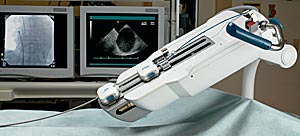Robotic catheter technology allows greater access in heart
Studies found that mapping and ablation using robotic catheter is appropriate and not associated with any acute complications.
In studies, the Sensei robotic catheter system allows physicians to map catheters in the heart in hard-to-reach locations during cardiac arrhythmia treatment.
With this technology, physicians would be able to extend their reach into areas of the heart using the robotically controlled catheter, said Frederic Moll, MD, founder and chief executive officer of Hansen Medical Inc., in a company press release.
A benefit of the Sensei system to physicians, who can spend four to six hours on electrophysiology procedures, is that the system allows physicians to perform procedures while seated and out of the field of direct radiation.
The system also allows the physicians to overcome the obstacles of catheter steering with accurate catheter movement in small, precise increments.
The Hansen Medical Sensei robotic catheter system received CE mark in September 2006 and is awaiting FDA clearance.
Efficacy and safety
Andrea Natale, MD, head of the section of pacing and electrophysiology, Cleveland Clinic Foundation, and colleagues performed clinical evaluations of the Sensei in Europe.
In a study published in the journal Heart Rhythm in 2005, the researchers reported that they evaluated seven patients, mean age 65, who presented for mapping and/or ablation of atrial arrhythmia. The patients included three women. The researchers performed 3-D reconstruction of the right atrial chamber anatomy using the robotic catheter and nonfluoroscopic electromagnetic endocardial mapping (CARTO) system.
|
Courtesy of Hansen Medical |
Since this study, a company spokesperson said, more than 63 mapping and ablation procedures have been performed on human patients in Europe using the Sensei system. These data were presented at the Heart Rhythm Society’s 26th Annual Meeting in 2006.
In the 2005 study, the mean fluoroscopy time was 14.5 minutes and mean procedure time was 88 minutes. The researchers performed mapping of the left atrium in two of the patients; all four pulmonary veins were accessed.
They used the Sensei in conjunction with CARTO to ablate existing arrhythmia in three patients. Using the Sensei, the researchers defined atrioventricular nodal reentry tachycardia as the clinical arrhythmia in two patients with supraventricular tachycardia. They performed successful modification of the slow pathway in these patients using the Sensei, with a mean fluoroscopy time of 38 minutes and a mean procedure time of 199 minutes. CARTO points were 79 in the patients, according to the researchers.
Results showed all patients were free of arrhythmia with no complications at four-month follow-up.
Hansen Medical will highlight the catheter in May at the Heart Rhythm Society’s 27th Annual Scientific Sessions in Denver. – by Lauren Riley
For more information:
- Visit www.hansenmedical.com
- Marrouche NF, Brachmann J, Wazni O, et al. Preliminary human experience using a novel robotic catheter remote control. Heart Rhythm. 2005;2(Suppl 1):S14-S15.

